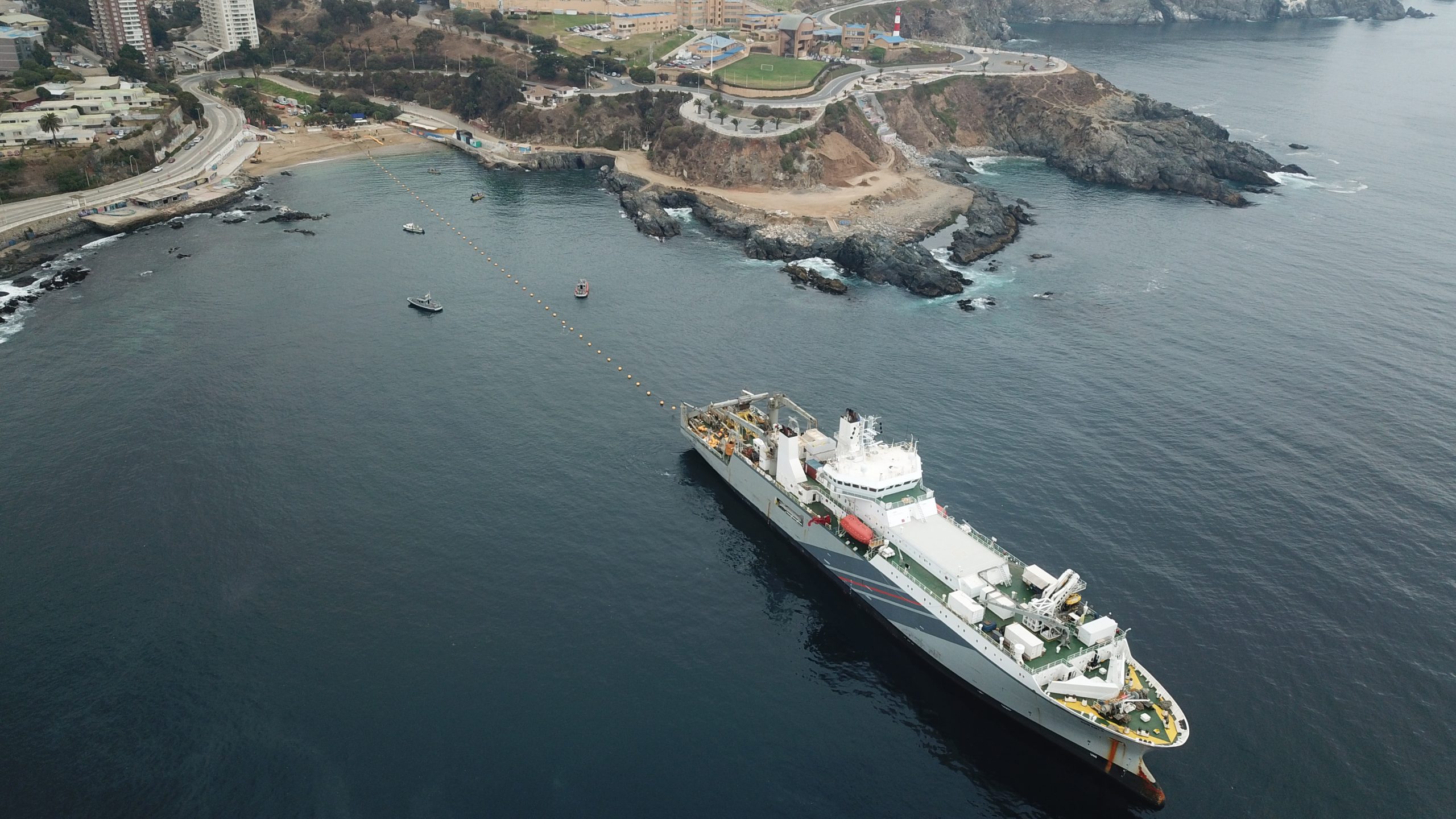The Humboldt Cable is the first submarine fiber-optic route that will connect Chile with Australia, enabling faster, more stable, and cost-effective connectivity between South America, Oceania, and the Asia-Pacific region.
This joint initiative between Google and the Chilean government aims to boost the digital economy of Chile and all of Latin America, while linking them to key global markets.
Fiber-optic cables form the backbone of the Internet by transmitting millions of data at high speed, with greater bandwidth capacity and low latency, meaning minimal delay in data transmission. This ensures smooth performance for critical real-time applications, from online gaming to remote monitoring of industrial processes, surveillance systems, financial transactions, and telemedicine.
Today, improved technological infrastructure is foundational to the development of advanced technologies such as Artificial Intelligence (AI), cloud computing, and services like 5G and the Internet of Things (IoT), all of which are essential for the digital and economic transformation of countries due to their significant impact on industrial, digital, and scientific productivity.
In this context, the construction of the 12,000-kilometer Humboldt submarine cable route, promoted by Google and the Chilean government through the state-owned company Desarrollo País, is considered a true revolution in local connectivity. The project will provide direct connectivity between South America and the Asia-Pacific region, reducing latency (accelerating data transmission) and granting greater autonomy and resilience to Latin American telecommunications, solidifying Chile’s position as a digital hub and technology center.
This public-private initiative is an example of innovative and efficient governance, involving multiple stakeholders who have demonstrated a long-term vision and strategic ability by partnering with Google, which has enabled the realization of this critical infrastructure for the country.
“Chile’s governance in the project has been fundamental in showcasing its value and attracting a range of stakeholders. This joint effort between Google and Desarrollo País aligns the long-term strategic objectives of both entities. For Desarrollo País, this new digital infrastructure positions Chile as a technology hub, facilitating the development of data centers and new technological solutions. It also fulfills the country’s vision of being the first in the region to connect directly with Asia and Oceania. We chose Google as a strategic partner for its extensive experience in deploying submarine cables worldwide, which guarantees serious execution with a world-class company,” explains Patricio Rey, CEO of Desarrollo País, the state-owned company responsible for managing long-term infrastructure in Chile.
The ambition to establish a direct fiber-optic link between South America and Asia originated in 2016, during Michelle Bachelet’s second term, initially considering China. In 2018, under the second administration of Sebastián Piñera, Chile’s Undersecretariat of Telecommunications (Subtel), with support from the Development Bank of Latin America and the Caribbean (CAF), commissioned studies on technical, legal, financial, and economic aspects, defining the Valparaíso-Sydney route as optimal. In 2021, Desarrollo País assumed the project, launching an international call the following year to find strategic partners for the cable’s construction. Google joined in 2023, showing a strong interest in collaborating with the Chilean state, sealing this public-private partnership under Gabriel Boric’s administration.
“This cable consolidates Chile’s position as the center of digital activity in South America, opening opportunities for new industries, jobs, and improved working and living conditions for thousands of people. Previously, there was no connectivity of this kind from south to south; this advancement is also geopolitically significant and should make us proud,” said Chile’s President Gabriel Boric during the initiative’s launch in January 2024.
Holistic Infrastructure
Fiber-optic cables connect continents and markets, driving the relentless rise of digital technologies, which in 2021 saw a $34 billion increase in annual export value across six Latin American economies (0.8% of total GDP), according to Google’s 2022 Digital Sprinters report. This value could quadruple, reaching $140 billion by 2030.
The Humboldt Cable will facilitate unprecedented technology exchange across the South Pacific, opening new doors for connections between South America and Asia’s major tech centers in Hong Kong, Tokyo, and Singapore.
This connection will be part of Google’s integrated infrastructure in Chile, which already includes a data center in Quilicura (2015), the Curie submarine cable (2020)—connecting Chile, the United States, and Panama—and a cloud region launched in Santiago (2021), the second in Latin America after Brazil.
“Chile has pursued a significant investment attraction policy and built digital capacities, complemented by the high availability of renewable energy. That is why Google has invested heavily in this country, establishing its only data center in Latin America and the Southern Hemisphere in Quilicura. Chile’s economic and political stability, as well as its extensive network of trade agreements, allow this center to provide services to the entire region,” says Nicolás Schubert, Government Relations and Public Policy Manager at Google Chile.
Patricio Rey also highlights Google’s digital infrastructure expertise as a key aspect of this public-private initiative, “which increases investment efficiency for the state and generates significant economies of scale,” he says.
While Chile will undoubtedly benefit, the Humboldt Cable aims to support all of South America. “The connection from Valparaíso benefits the Southern Cone and the region in general, allowing other companies to use the open cables. This facilitates new connections between data centers in Chile and Asia, creating expansion opportunities for telecom and tech companies. Currently, Chile’s submarine communications are primarily with the United States; this new connection opens access to Australia and Asia,” explains Cristian Ramos, Director of Infrastructure Development at Google.
Tech Hub and AI
According to Schubert, all of this will enhance users’ internet experience and be essential for real-time applications. “These advancements will drive Chile’s digital development and highlight it as a regional benchmark,” says Schubert, specifically referring to the development of technologies like Artificial Intelligence (AI) and cloud computing.
This is no small matter. The 2023 Global Interconnection Index predicts that 85% of global companies will expand multicloud access across multiple regions by 2025, with data traffic between the Asia-Pacific and South America projected to grow at an average annual rate of 28% over the next 20 years.
Thus, the Chilean government’s strategy is to leverage the Humboldt Cable to position Valparaíso as an emerging hub in South America. “Google’s commitment to Chile reflects the confidence that international technology investors have in our country, which is crucial for establishing it as a digital hub,” affirms Patricio Rey.
For Chile, its renewable energy advantages could promote data center installations, pushing cloud capabilities and digital services that will benefit large corporations, SMEs, startups, and emerging sectors. “Developers and creators will experience an enhanced environment. We saw this with cloud service investments. New infrastructures not only deliver direct benefits but also foster an ecosystem. This was evident with the Curie cable, which brought significant economic benefits to the country as a whole—a multiplier effect that allowed many other businesses and industries to become more efficient,” states Cristian Ramos.
Greater access to cloud computing will strengthen technologies such as IoT monitoring, which is already impacting companies of national interest, like Codelco. Chile’s state-owned copper mining company increased its production by 4% after implementing integrated operations centers and IoT technologies.
Scientific research will also benefit from the cloud. “Accelerated data transfer will impact astronomical observation in northern Chile, which generates large volumes of data that need to be transmitted to universities and research centers. Previously, this data took traditional northern hemisphere routes across the Pacific. Now, with a direct route, we expect significant improvements in speed and cost, benefiting science as well,” says Schubert.
Economic impact is another measurable benefit. According to Analysys Mason, Google’s submarine cables in Latin America and the Caribbean, spanning five countries, will generate a cumulative GDP increase of $178 billion from 2017 to 2027, creating approximately 740,000 additional jobs by 2027, representing an annual GDP increase of 1.08%. “For example, the Curie cable increased Chile’s international outbound capacity (more data traffic to and from other countries) by 30%. Between 2020 and 2027, the Curie cable is expected to contribute $19.2 billion and create 67,000 jobs in the region,” says Google’s Director of Infrastructure Development.
High-Level Engineering
According to the 2024 Cable Map, since 2018, Google has invested in 29 submarine fiber-optic cable projects, five of which connect Latin America: Monet (Brazil and the United States), Tannat (Argentina, Uruguay, and Brazil), Curie (Chile, Panama, and the United States), Junior (Rio de Janeiro and Praia Grande), and Firmina (United States, Brazil, Uruguay, and Argentina). These are high-level engineering projects, requiring significant investment and involving simulations, surveys, manufacturing, and seabed installation.
Humboldt, meanwhile, is under development. “This year, we are focused on obtaining permits for seabed studies, essential to plotting the cable route. We’ve completed a preliminary study using underwater mapping and now need to confirm the route with a detailed survey. Concurrently, we will begin the cable’s construction—a long and complex process involving the complete fabrication of the cable and the installation of repeaters. Once the route is finalized and permits are obtained, we will proceed with seabed installation, ensuring a service life of about 25 years,” explains Ramos.
The Curie cable’s landing in Valparaíso took place in April 2019. “The cable reached the shore and was covered with sand and anchored on land to prevent it from being pulled back to sea. The cable was pre-constructed in a factory and then laid on the seabed using specialized ships,” explains Ramos, illustrating what to expect soon with the Humboldt cable.
The Humboldt cable is scheduled for installation in 2025 and will be operational by 2026. “This will also be enhanced by Google’s Pacific Connect initiative—which connects French Polynesia, Fiji, Guam, the Mariana Islands, Japan, Hawaii, and the United States—strengthening network resilience and linking Pacific islands with continents. The more connection nodes, the more resilient the networks, allowing traffic to find alternative routes in case of outages,” concludes Cristian Ramos, Google’s Director of Infrastructure Development.









